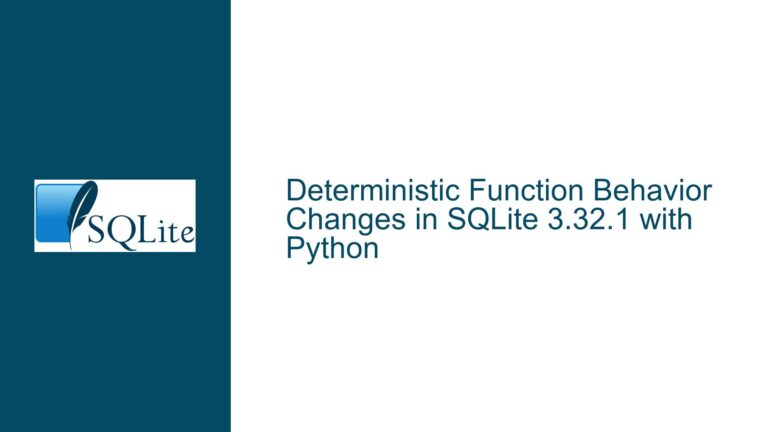Performance Implications of Using 36-Character GUIDs as Primary Keys in SQLite
Primary Key Design Choices and Storage Overhead in SQLite
When designing a SQLite database schema, the choice of primary key (PK) type and structure directly impacts storage efficiency, query performance, and index management. A 36-character GUID stored as a TEXT type for primary keys introduces several considerations:
RowID vs. Explicit Primary Key Behavior:
In SQLite, tables default to having an implicit 64-bit signed integerROWIDcolumn unless declared asWITHOUT ROWID. When a column is explicitly declared asINTEGER PRIMARY KEY, it aliases theROWID, enabling direct row access via a single B-tree traversal. Non-integer PKs (e.g.,TEXTGUIDs) create a secondary index structure where the declared PK becomes a unique index, and theROWIDremains the true storage locator. This forces two-step lookups: first resolving the GUID to aROWID, then fetching the row data. ForWITHOUT ROWIDtables, the GUID becomes the direct storage key, but its 36-byte size inflates the primary B-tree node entries, increasing disk I/O and memory consumption.Storage Amplification:
GUIDs stored as 36-characterTEXTvalues consume 36 bytes per instance (assuming UTF-8 encoding). In contrast,INTEGERkeys use 1–8 bytes depending on magnitude. In tables with millions of rows, this difference compounds: a 1-million-row table with GUID PKs requires ~36 MB of storage for PKs alone, versus ~4 MB for 4-byte integers. Foreign key columns referencing GUIDs inherit this overhead, amplifying storage costs across related tables.Index Fragmentation and Page Utilization:
SQLite stores tables and indexes as B-trees. Randomly generated GUIDs (version 4 UUIDs) disrupt sequential key insertion, causing page splits and fragmentation. This reduces the number of rows per database page, increasing the number of disk accesses required for range scans or full-table operations.WITHOUT ROWIDtables exacerbate this issue, as the GUID’s size directly affects the clustering of row data.
Performance Degradation from GUID Key Characteristics
The use of GUIDs as primary keys introduces performance bottlenecks through four primary mechanisms:
Double-Lookup Penalty in Default Table Configurations:
Queries filtering on a non-ROWIDPK (e.g.,SELECT * FROM users WHERE guid = '...') first traverse the GUID’s unique index to retrieve theROWID, then access the main table B-tree using thatROWID. This adds latency proportional to the depth of both B-trees. While SQLite’s query planner may optimize this via covering indexes, the physical storage separation between index and data remains a fundamental constraint.Suboptimal Join Performance with Foreign Keys:
Tables referencing GUID-based PKs via foreign keys (FKs) must store the 36-byte GUID in each FK column. Joins between parent and child tables compare these large values, which is slower than integer comparisons. Composite indexes involving GUIDs further bloat index sizes, reducing the number of index entries per page and increasing lookup times.Inefficient Text vs. Binary Comparisons:
TEXTGUIDs require character set comparisons, which are slower than binary (BLOB) or integer comparisons. Collation sequences (e.g.,BINARY,NOCASE) add overhead, especially when sorting or usingORDER BYclauses. Storing GUIDs as 16-byteBLOBvalues (for 128-bit UUIDs) eliminates collation overhead and reduces comparison times by ~30% in benchmarks.Write Amplification in Index Maintenance:
Inserting rows with random GUIDs into indexed columns causes non-sequential writes to the index B-tree, increasing write amplification. This is particularly detrimental in write-heavy workloads, where SQLite must frequently rebalance tree nodes. Auto-incrementing integers, by contrast, allow append-only writes to the PK index, minimizing page splits.
Optimizing GUID Usage in SQLite Schemas
To mitigate the performance impact of GUIDs while retaining their uniqueness benefits, employ the following strategies:
Schema Redesign with Surrogate Integer Keys
Replace GUID PKs with
INTEGER PRIMARY KEY:
Declare an auto-incrementing integer as the PK and add aUNIQUEconstraint on the GUID column:CREATE TABLE entities ( id INTEGER PRIMARY KEY, guid TEXT UNIQUE NOT NULL, -- other columns );Foreign keys should reference
idinstead ofguid, reducing FK storage and join overhead.Migrate Existing Data to Surrogate Keys:
For tables already using GUID PKs, create a new table with the surrogate key, copy data, and rebuild dependencies:-- Step 1: Create new structure CREATE TABLE new_entities ( id INTEGER PRIMARY KEY, guid TEXT UNIQUE NOT NULL, -- other columns ); -- Step 2: Copy data INSERT INTO new_entities (guid, ...) SELECT guid, ... FROM entities; -- Step 3: Recreate dependent objects and update FKs
GUID Storage and Index Optimization
Store GUIDs as
BLOBInstead ofTEXT:
Convert GUIDs to 16-byte binary format (e.g., UUID bytes) to save space and accelerate comparisons:CREATE TABLE entities ( id INTEGER PRIMARY KEY, guid BLOB UNIQUE NOT NULL );Application code must encode/decode GUIDs to/from binary (e.g., using
hex()/unhex()in SQL or binary binds in application code).Use
WITHOUT ROWIDJudiciously:
If surrogate keys are infeasible, declare the table asWITHOUT ROWIDto eliminate the double-lookup penalty:CREATE TABLE entities ( guid TEXT PRIMARY KEY ) WITHOUT ROWID;Reserve this for small tables or where GUIDs are frequently queried, as large
WITHOUT ROWIDtables suffer from fragmentation.Implement Sequential GUIDs:
Use GUID variants that embed sequential elements (e.g., COMB GUIDs, UUIDv7) to improve index locality. These GUIDs start with a timestamp or sequence number, reducing page splits during inserts.
Query and Index Tuning
Covering Indexes for GUID-Based Queries:
Create covering indexes that include all columns accessed by frequent queries to avoid table lookups:CREATE INDEX idx_entities_guid ON entities(guid) INCLUDE (name, created_at);Benchmark Alternative Collations:
TestBINARYvs.NOCASEcollations forTEXTGUIDs under realistic query loads. UseCOLLATE BINARYexplicitly if case sensitivity is required:CREATE TABLE entities ( guid TEXT PRIMARY KEY COLLATE BINARY ) WITHOUT ROWID;Monitor Index Fragmentation:
Periodically runANALYZEand checksqlite_stat1to assess index efficiency. Rebuild fragmented indexes withREINDEXorVACUUM.
By systematically addressing storage overhead, comparison efficiency, and index design, developers can leverage GUIDs for global uniqueness without sacrificing SQLite’s performance characteristics. Surrogate integer keys remain the gold standard for high-throughput applications, while optimized GUID storage and indexing strategies offer a pragmatic compromise for distributed systems requiring decentralized key generation.






